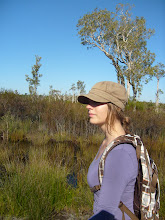 |
| Me and my friend in the Simpson Desert Pic by Shaun Doyle |
This reptile might look fearsome but
it is not as dreadful as its name suggests. In a land filled with deadly
dangerous animals, this one uses clever disguise and innovation to survive.
Poisonous? No
Fast? No
Ferocious? Eh.. no. When picked up
it might looked slightly annoyed and then just close its eyes.
So how exactly does it survive?
Thorns. Lots of them. Not many animals
enjoy swallowing something that looks worse than a cactus.
 |
| Holding at your own risk! Pic by Enyi Guo |
Camouflage. You don’t see a thorny
devil until your foot hovers right over one and you were happening to look
where you were walking. Even when you know what you are looking for they are
exceedingly tricky to find. Their body colouration is patchy, partly the red of
the desert sand, partly the yellow/green (it varies per individual) of the
vegetation. When the animal is undisturbed the colours are quite dull. However,
when moving or picked up they brighten up considerably as a warning sign to
potential predators: do not think about eating me, it’s going to be unpleasant!
 |
| Body colouration can rapidly change. Here, the colours are dark and distinct. Pic by Shaun Doyle |
Deception. On its neck, it grows a
bump with thorns about the same size as its head. When threatened the thorny
devil tends to tuck its real head between its front legs which manoeuvres this
bump where the head usually is. Many predators will aim for the head first when
attacking. When they get in contact with the spines some might decide they like
their stomach without holes and dismiss the attack. The moloch survives without
damage to its real head.
 |
| Notice the 'extra' head on top of its neck. Pic by Shaun Doyle |
Innovation. The thorny devil is
endemic to Australia, meaning it is only found there. It thrives in the dry,
sandy interior of the continent. One thing is very hard to come by in this
place: water. Luckily, the thorny devil has got a rather unique solution to
this. In its skin it has a system of small grooves, all leading toward the
corners of its mouth. These grooves collect and move water from the entire
surface of its body towards its mouth by means of capillary action. The only
thing he has to do is swallowing. If you put a moloch with its feet in a dish
of water, within a matter of seconds its body will be glistening with moisture
and without lowering its head it will start to swallow the water brought to its
mouth from its feet. All tested by yours truly of course.
 |
| A thorny devil can drink via its feet |
You won’t find these animals in
captivity often; they are notoriously hard to keep. Outside Australia, only a
zoo can get a permit to keep them as they are a protected species. And few zoos
actually do keep them. The problem lies in the feeding behaviour of these
animals. They are very picky eaters, only feeding on 2-3 species of tiny black
ant. And even then, they will only eat those when they are moving in a line,
picking them off one by one, consuming around 2000 every day. So keeping one in
captivity requires keeping a few large ant colonies of a particular ant species
as well, and training them to walk in a line through the enclosure of the
thorny devil where most of them will be eaten. It is a daunting task.
In short, I am a lucky person to
have such an elusive new friend!


No comments:
Post a Comment